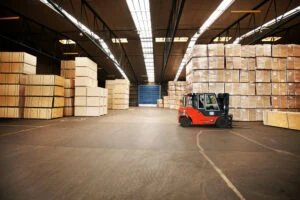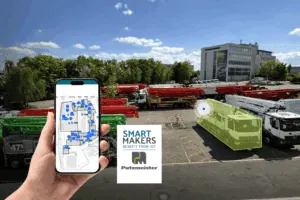In the ever-changing world of the manufacturing industry, efficiency is a precious commodity. But how can this be achieved in the face of today's challenges? The answer could lie in IoT-based tool tracking. This article explores the promising potential of this technology to optimize production processes and meet the demands of a rapidly changing environment.
Delving into the world of connected tools, we reveal how IoT-driven tool tracking not only challenges the status quo, but also shows a way to redesign manufacturing processes. From inventory management to data analysis, this innovative solution promises to increase efficiency and enable manufacturers to face the demands of the future with confidence and a pioneering spirit.

The basics of IoT-based tool tracking
IoT-based tool tracking is a concept that is revolutionizing the manufacturing industry. It promises not only efficiency gains, but also solutions to the challenges of modern production environments. In this article, we focus on how IoT-based tool tracking can optimize production processes.
By equipping tools with a variety of sensors and wireless communication capabilities, this technology enables real-time monitoring and tracking of tools with unprecedented precision.
This allows manufacturers to closely monitor the location, condition and use of their tools. By collecting and analyzing this data, inefficient processes can be identified and improved. In addition, precise tool tracking helps to avoid losses, theft and unnecessary downtime.
Thus, IoT-based tool tracking not only ensures that the right tools are in the right place at the right time, but also creates the basis for data-driven decision-making and optimized production.
IoT-based tool tracking in detail
IoT-based tool tracking relies on real-time data and monitoring in modern manufacturing environments. With the help of tool tracking devices based on advanced technologies and integrated via communication protocols, manufacturers can optimize their production processes. Several advantages become apparent:
Efficient tool inventory management
The IoT-based tool tracking system enables precise inventory management of tools. By accurately identifying and tracking each tool, stock shortages can be avoided and availability ensured. Real-time monitoring ensures that production lines are continuously supplied with the required tools, without delays or interruptions.
In addition, precise management enables optimal use of resources, as superfluous tools can be identified and bottlenecks detected at an early stage. This not only leads to smoother production processing, but also to considerable cost savings, as unnecessary investments in tool stock are avoided.
IT-supported tool tracking thus creates a solid basis for efficient and responsive production that meets the requirements of the modern competitive environment.
Minimize downtime and increase productivity
With real-time data, manufacturers can minimize downtime and increase productivity. Early detection of potential problems enables rapid intervention and reduces costly interruptions.
Thanks to IoT-based tool tracking, deviations from the optimum condition of the tools can be detected and rectified immediately. This enables a seamless production flow and prevents longer downtimes due to unexpected failures.
In addition, production processes can be continuously analyzed and optimized based on the real-time data collected to identify and eliminate bottlenecks or bottlenecks. The combination of real-time monitoring and data-driven analysis thus creates an environment in which productivity is maximized and efficiency is increased - a crucial factor in today's competitive manufacturing environment.

Prevention of tool loss and theft
The technology helps prevent tool loss and theft. Precise location tracking can quickly locate missing tools and prevent possible thefts. Real-time location not only enables the precise localization of tools, but also creates transparency about their movements in the production environment. This not only minimizes losses, but also increases safety in the production halls.
Tool theft can be detected and prevented in good time, as the technology sends immediate notifications in the event of suspicious movements or changes in location. The IoT-controlled tool tracking system therefore not only offers efficient tool management, but also an additional layer of security that ensures the integrity of production processes.
Data-based decisions
Real-time data enables well-founded decisions in production. Manufacturers can access up-to-date data to identify bottlenecks, deploy resources efficiently and eliminate bottlenecks. IoT -based tool tracking provides insights into the performance and utilization of tools so that optimization potential can be identified and strategic measures can be initiated in a targeted manner.
Continuous data collection enables trends and patterns to be analyzed in order to continuously improve production and optimally meet market requirements. With such a data-driven approach, manufacturers can react with agility and adapt their production to changes in real time in order to remain competitive.
Maintenance optimization
IoT-controlled tool tracking optimizes maintenance processes. Continuous monitoring of tool status allows preventive maintenance measures to be planned in order to minimize downtime and extend tool life.
These multiple benefits illustrate how IoT-based tool tracking not only revolutionizes manufacturing processes, but also makes a fundamental contribution to increasing efficiency and optimizing the entire production environment.
Challenges and trends
The implementation of IoT-based tool tracking poses challenges that need to be overcome. The networking of tools requires a robust infrastructure that enables real-time data transmission without disrupting production processes. Data privacy and security are also of paramount importance to protect confidential information and meet compliance requirements.
In addition, manufacturers must prepare their employees for the new technology and ensure that they understand and can utilize the benefits of IoT-driven tool tracking.
We will also address emerging trends that will shape the future of IoT-based tool tracking. Artificial intelligence (AI) plays a central role in analyzing large amounts of data. AI-supported analyses can recognize patterns, make predictions and further increase production efficiency.
Another forward-looking trend is predictive maintenance. Through continuous monitoring and analysis, tools can be optimized so that maintenance measures are carried out before a potential failure occurs. This minimizes downtimes and maximizes the service life of the tools.
These trends illustrate that IoT-based tool tracking is constantly evolving and opening up new opportunities for efficiency gains and optimization in the manufacturing industry. By understanding the challenges and utilizing the latest trends, manufacturers can take full advantage of this technology and strengthen their competitiveness.

Conclusion and outlook
IoT-based tool tracking has the potential to revolutionize manufacturing processes and increase efficiency. Manufacturers are invited to explore this innovative technology and optimize their production processes.
Precise tool tracking, efficient inventory management and data-driven decision making can minimize production bottlenecks and increase overall efficiency. IoT -controlled tool tracking thus represents a pioneering solution for the modern manufacturing industry.
The future of manufacturing lies in the integration of advanced technologies such as IoT-based tool tracking. This innovation will not only increase efficiency, but also permanently change the entire production landscape. Manufacturers who embrace this technology early will be able to strengthen their competitiveness and meet the changing needs of the industry.
The vision of connected manufacturing is more tangible than ever with IoT-based tool tracking. This article provides an informative overview of the potential of IoT-based tool tracking in production. It is aimed at decision-makers and project managers who are looking for innovative solutions to optimize their production processes.
By understanding the opportunities and benefits of this technology, readers can future-proof their manufacturing processes and achieve their business goals more efficiently.




